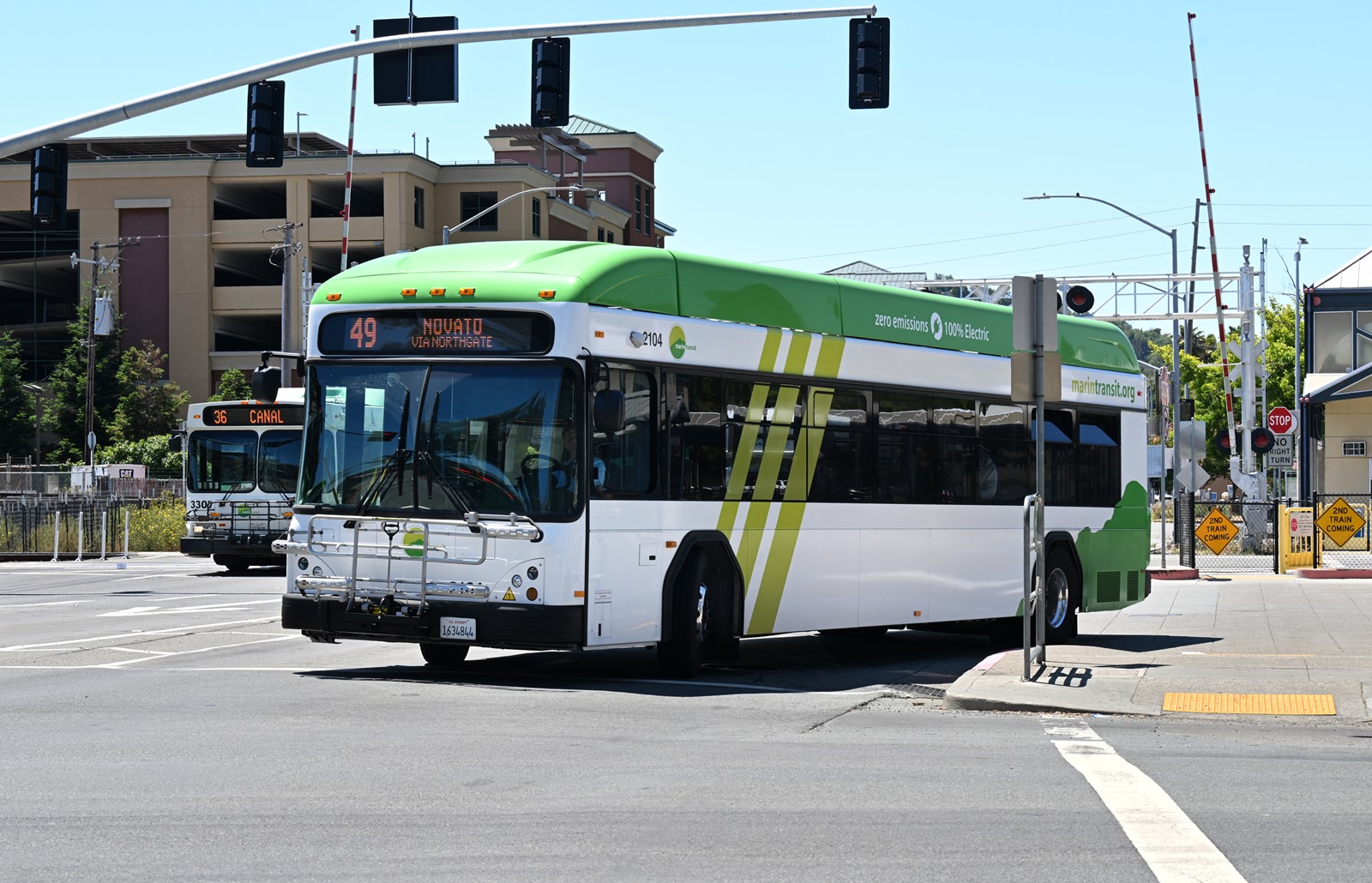
Marin Transit is scaling back a plan for an electric bus yard in San Rafael because of site constraints at the proposed lot.
The 3.5-acre site at 1075 E. Francisco Blvd. is smaller than the 5 to 6 acres that district officials had wanted. Last year, officials agreed to purchase the property to potentially construct a multistory complex to make up for the limited ground space.
However, the lot sits on bay mud, and building up would add cost and potential environmental impacts. The project team determined the site could meet the district’s minimum requirements with a single-story design.
“So the programming is constrained, and the final project won’t include all of the desired components,” Nancy Whelan, the Marin Transit general manager, told the board at its July 7 meeting.
The agency is under a state mandate to electrify its fleet by 2040. That means that 100% of new bus purchases must be zero-emission vehicles by 2029. In addition to the mandate, the agency has a responsibility to reduce emissions.
In order to accommodate the transition, Marin Transit needs a home for its bus fleet. Agency officials have been looking for a site for more than 10 years, investigating more than 65 properties, and have made 10 offers, Whelan said.
In 2023, the Biden administration awarded the agency a $31.5 million grant to help it realize its goal. About $2.2 million of that grant is being dedicated to support workforce development and child care. Marin Transit is providing a $15.1 million local match for a total investment of about $46.7 million in a new hub.
The agency has not approved a specific project on the San Rafael site, but the intent is to construct the new facility.
Due to the site constraints, the project team is proposing reducing the number of bus bays from six to five and providing parking for about 49 buses instead of 79. Staff parking also is proposed to be reduced to 57 from 73, Whelan said. The design process is iterative, so some of the numbers could change, Whelan said.
There are other trade-offs, Whelan said.
Break rooms and restrooms for maintenance staff and drivers will be combined, rather than separated by division.
There is no room for the planned dispatch center or training and conference room. Those spaces will need to be relocated within the agency’s bus facility at 600 Rush Landing in Novato, Whelan said.
Redevelopment of the Rush Landing site would be treated as a separate project, she said. The district has budgeted $380,000 for design, which would include reconfiguration of the building’s interior and rehabilitation of the parking lot. The agency is seeking funding for construction.
Whelan said the project team also determined that providing onsite child care is not feasible at the San Rafael lot. Staff are considering options for an offsite child care center or providing vouchers to employees to help subsidize the cost. Both options meet the requirements of the grant funding.
In response to concerns lodged by San Rafael officials last year, Marin Transit also had pledged to explore the potential for housing and retail as part of the project. But that is not feasible either, for the same reasons, Whelan said.
Staff are still considering onsite food vending such as a food truck, electric vehicle charging for public use and parking for a car share program.
In March, the Marin Transit board approved a community outreach plan, and staff have already been providing information at community events, Whelan said.
The agency has planned a transit open house event on July 23, which will include information on the electric bus yard plan, among other transit topics.
The project will require California Environmental Quality Act and National Environmental Policy Act clearance. Each requires specific environmental reporting and mitigation.
Whelan said staff plan to issue a draft environmental analysis in August for public review and comment. The final reports are expected to be made available in September. A staff recommendation to the board is planned for October.
If the project is approved, next year would be dedicated to designing the facility. Construction would begin in 2027. The schedule calls for the site to be operational by 2030.
Marin County Supervisor Stephanie Moulton-Peters, a Marin Transit board member, said it’s unfortunate that the agency has to give up some of the desired amenities. However, she applauded staff for migrating some of the features offsite and for seeking solutions for the child care component.
“It sure is good that we’re doing this now to meet those CARB goals,” said Moulton-Peters, referring to the California Air Resources Board mandate for zero-emission vehicles. “It’s right just in time with their schedule.”
Marin County Supervisor Mary Sackett asked why the plan does not include solar charging for the buses.
Whelan said there will be solar for the building portion of the site.
“We’d have 50, 40-some-odd buses, and we won’t be able to store enough solar and have enough solar panels to be able to achieve that,” said Whelan, noting that was a common finding among other similar facilities staff toured for comparison.
Sackett asked if staff would be looking to purchase 100% renewable energy through MCE’s Deep Green program instead. Whelan said yes.
Circle Point has been hired to conduct the CEQA analysis for about $210,000.
Marin Transit has allocated about $1.9 million toward environmental reporting and design and engineering for the year, according to the agency’s budget.
When asked after the meeting whether Marin Transit would need another lot, Whelan said, “We were fortunate to acquire the site in San Rafael, albeit smaller than what we had hoped for.”
“While the goal was to have a single, centralized fixed route maintenance and operations facility, available sites in Marin County are rare,” she said. “Between the Francisco and Rush Landing sites, we can accommodate our current needs.”


 PREVIOUS ARTICLE
PREVIOUS ARTICLE
